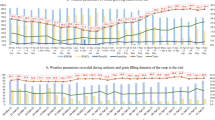Abstract
Bread wheat Triticum aestivum L. possesses a genetic variation for the ability to survive and reproduce under salt stress conditions. Durum wheat (T. durum Desf.) is in general more sensitive in comparison to bread wheat, however, exceptions can be found showing the same extent of salt tolerance. Endemic wheats in general are characterised by a high adaptability to their environment. The level and variability of salt tolerance were assessed in a germplasm collection of 144 winter and spring wheat accessions from Georgia comprising Triticum aestivum L., T. durum Desf., T. dicoccon Schrank, T. polonicum L. and Georgian endemics: T. carthlicum Nevski, T. karamyschevii Nevski, T. macha Dekapr. et Menabde, T. timopheevii (Zhuk.) Zhuk. and T. zhukovskyi Menabde et Ericzjan. The accessions were tested for salt tolerance at the germination stage. Large variability in salt tolerance within the Georgian germplasm was found among the different wheat species. The endemic hexaploid winter wheat T. macha and the endemic tetraploid wheat T. timopheevii were among the most tolerant materials, thus presenting promising donors for salt tolerant traits in future breeding efforts for salinity tolerance in wheat.


Similar content being viewed by others
References
Ahsan M, Wright D, Virk DS (1996) Genetic analysis of salt tolerance in spring wheat. Cer Res Comm 24:353–360
Ayers RS, Westcott DW (1994) Water quality for agriculture. FAO irrigation and drainage papers -29
Börner A, Freytag U, Sperling U (2006) Analysis of wheat disease resistance data originating from screenings of Gatersleben genebank accessions during 1933 and 1992. Genet Resour Crop Evol 53:453–465. doi:10.1007/s10722-004-1158-8
Dekaprelevich LL (1942) The role of Georgia in wheat origin. Bull Ga Acad Sci 3:153–160
Dubcovsky J, Maria GS, Epstein E, Luo MC, Dvorak J (1996) Mapping of the K+/Na+ discrimination locus in wheat. Theor Appl Genet 92:148–454. doi:10.1007/BF00223692
Flowers TJ (2004) Improving crop salt tolerance. J Exp Bot 55:307–319. doi:10.1093/jxb/erh003
Mano Y, Nakazumi H, Takeda K (1996) Varietal variation in and effects of some major genes on salt tolerance at the germination stage in barley. Breed Sci 46:227–233
Menabde VL (1948) (Wheats of Georgia) in Russian, Acad. of Sci. of Georgian SSR, Tbilisi, 350 pp
Menabde VL (1961) Wheats of Georgia and their part in general evolution of the genus Triticum L. Works Tbilisi Inst Bot 21:256–259
Munns R, Filmer M (2007) Paving the way for salt-tolerant wheat. Farming ahead 186:50–53
Munns R, James RA (2003) Screening methods for salinity tolerance: a case study with tetraploid wheat. Plant Soil 253:201–218. doi:10.1023/A:1024553303144
Munns R, Hare RA, James RA, Rebetzke GJ (2000) Genetic variation for improving the salt tolerance of durum wheat. Aust J Agric Res 51:69–74. doi:10.1071/AR99057
Nevo E (1995) Genetic resources of wild emmer, Triticum dicoccoides, for wheat improvement: news and views. Proc 8th intern wheat genet symp, Beijing, Agricultural Scientech Press, Beijing, China, pp 79–87
Pitman MG, Läuchli A (2002) Global impact of salinity and agricultural ecosystems. In: Läuchli A, Lüttge U (eds) Salinity: environment-plants-molecules. Kluwer Academic Publishers, Dordrecht/Boston/London, pp 1–20
Prazak R (2002) Salt tolerance of Aegilops species and T. aestivum seedlings. In: Swiecicki W, Naganowska B, Wolko B (eds) Broad variation and precise characterization—limitation for the future. Proc XVI EUCARPIA Genetic resources section workshop, Poznan, Poland, pp 257–259
Schachtmann DP, Munns R, Whitecross MI (1991) Variation in sodium exclusion and salt tolerance in Triticum tauschii. Crop Sci 31:992–997
Schultze-Motel J (1989) Archäologische Kulturpflanzenreste aus der Georgischen SSR (Teil 2). Kulturpflanze 37:415–426. doi:10.1007/BF01984621
Shah SH, Gorham J, Forster BP, Wyn Jones RG (1987) Salt tolerance in the Triticeae: the contribution of the D genome to cation selectivity in hexaploid wheat. J Exp Bot 38:254–269. doi:10.1093/jxb/38.2.254
Weidner A, Börner A (2004) Salztolerante Weizen-Herkünfte aus dem Gaterslebener Genbanksortiment. Vortr Pflanzenzüchtg 63:205–209
Acknowledgements
G. Badridze wishes to thank the German ‘Gemeinschaft zur Förderung der Kulturpflanzenforschung Gatersleben e.V.’ for financial support.
Author information
Authors and Affiliations
Corresponding author
Rights and permissions
About this article
Cite this article
Badridze, G., Weidner, A., Asch, F. et al. Variation in salt tolerance within a Georgian wheat germplasm collection. Genet Resour Crop Evol 56, 1125–1130 (2009). https://doi.org/10.1007/s10722-009-9436-0
Received:
Accepted:
Published:
Issue Date:
DOI: https://doi.org/10.1007/s10722-009-9436-0




